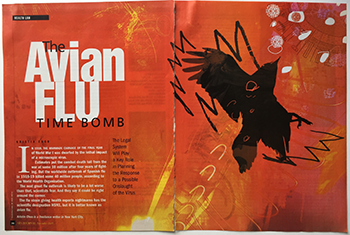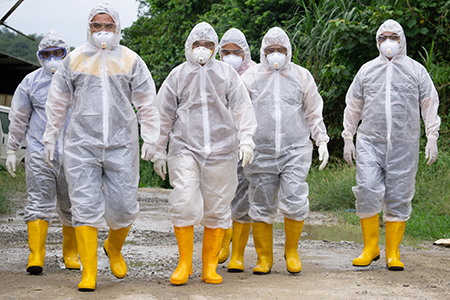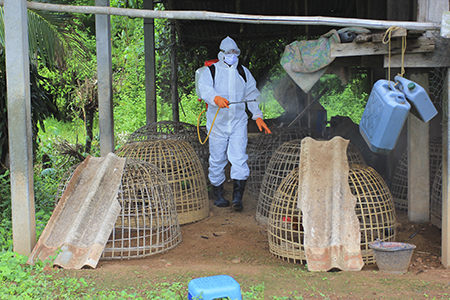The Avian Flu Time Bomb

Image from Shutterstock.
In 1918, the manmade carnage of the final year of World War I was dwarfed by the lethal impact of a microscopic virus. Estimates put the combat death toll from the war at some 10 million after four years of fighting. But the worldwide outbreak of Spanish flu in 1918-19 killed some 40 million people, according to the World Health Organization.
The next great flu outbreak is likely to be a lot worse than that, scientists fear. And they say it could be right around the corner.
The flu strain giving health experts nightmares has the scientific designation H5N1, but it is better known as avian flu.
New strains of influenza, a family of viruses that generally attack the respiratory system, pop up all the time.

This story appeared in the November 2005 issue of the ABA Journal. It has been updated with new images.
Since the 1918-19 pandemic, there have been other deadly outbreaks; flu strains in 1957 and 1968 each killed more than a million people. But the more typical flu outbreak generally is treated as little more than a seasonal annoyance that keeps the sufferer curled up in bed on winter mornings instead of heading off to work.
“It is seen as almost a cuddly disease,” notes Thomas Abraham, a Hong Kong-based journalist and author of Twenty-First Century Plague: The Story of SARS. But on the basis of what science knows so far, avian flu isn’t cuddly. It’s vicious.
When the virus first emerged in 1997 among Hong Kong’s domestic chicken population, 18 people were infected, six of whom died. Between then and Sept. 29, 2005, there were another 116 confirmed cases of avian flu among humans in Southeast Asia, most of them linked to exposure to infected chickens, according to the World Health Organization. Statistically, that number of cases is barely a drop in the bucket. What scares medical experts is that 60 of the human victims died from the disease a chilling fatality rate of more than 50 percent. By comparison, Spanish flu killed about 2 percent of its victims.
“We’ve never seen anything like this before with influenza,” says Dr. Donald Henderson, a resident scholar at the Center for Biosecurity at the University of Pittsburgh Medical Center.
So far, the virus does not appear to have developed the ability to travel easily from human to human, which would make a pandemic possible. But one of the striking characteristics of H5N1 is that it mutates rapidly as it replicates in infected animals and humans. And the chances for more contact with humans are increasing.
The Legal Response
There is growing consensus that the medical, legal and business communities, along with governments, must mobilize to prepare for a possible avian flu pandemic.
By necessity, the legal system will be a key component in efforts to develop a response. “Lawyers are going to be called upon,” says Hal S. Katz of Austin, Texas, who chairs the Public Health and Policy Interest Group in the ABA Section of Health Law. “And they can either play a role that helps the process and ensures that our communities are safe, or they can get in the way of the responders’ efforts.”
Chuck Ludlam of Washington, D.C., retired counsel to U.S. Sen. Joe Lieberman, D-Conn., ticks off a number of legal questions that will arise in the event of a major disease outbreak: Who will manage quarantines? Who will enforce them? Can health workers be forced to work in contagious environments? Can the Food and Drug Administration speed up its approval process for untested experimental medicines? Who would cover liability for harm from using those medicines? Can the government force people to be vaccinated?
“The government has power only to the extent that it has power through legal rights,” Ludlam says. “If the legal system is compromised, everything else will be more difficult.”
Some scientists warn that it may be just a matter of time—and perhaps not much time—before H5N1 invades the human population, following a path that could reach pandemic proportions in a matter of weeks.
While the H5N1 virus still is confined primarily to aquatic and domesticated birds, it has been identified in such animals as eagles, tigers and pigs. It is spreading geographically, too, from its original environs in China and Southeast Asia to Siberia, Mongolia and Kazakhstan, leading the European Union to impose a ban on imports of Russian poultry.
By late September, it had spread to Indonesia, where more than 30 people were reportedly hospitalized with suspected H5N1 and six people had died.
“Every time there is a new transmission, there is another opportunity to create a virus capable of being readily transmitted from human to human,” says Dr. Michael T. Osterholm, director of the Center for Infectious Disease Research and Policy, and associate director of the Department of Homeland Security’s National Center for Food Protection and Defense, both based at the University of Minnesota in Minneapolis.
Osterholm, in the July/August 2005 issue of Foreign Affairs, published by the Council on Foreign Relations, calls for “a detailed operational blueprint that can get a population through one to three years of a pandemic. Such a plan must involve all the key components of society.”
Lawyers must participate in the planning, Ludlam says. Legal questions should be considered before “the middle of a catastrophe that we do not understand and everybody is in a state of panic.”
“We need to think about them and war-game them all in advance so that we have thought through all of the scenarios,” he says.
Some of the issues are getting more attention on the policy front. The Model State Emergency Health Powers Act, for example, has been introduced in 45 legislatures, and 37 states have adopted at least some of its provisions.
The model act was written in 2001 by lawyers at the Center for Law and the Public’s Health to give states a reference point for evaluating and updating their public health laws. The center, at Johns Hopkins and Georgetown universities, serves as a resource on health law issues. It was founded in 2000 with funding from the U.S. Centers for Disease Control.
The model act would give governors sweeping powers in public health emergencies but would check those powers with due process provisions, time limits and legislative protections. Under the act, a state would not be empowered to force an individual to be vaccinated, but it would have the power to isolate or quarantine people who refuse vaccination. And while the law would not impose criminal penalties on health care workers who don’t show up during a medical crisis, it would allow the state to deny them licensure.
The center now has folded the Model State Emergency Health Powers Act into the Turning Point Model State Public Health Act, which addresses a broad range of emergency and nonemergency public health issues. The entire turning point act or specific provisions have been introduced in 32 state legislatures. (Information on both model acts is available on the center’s Web site, www.publichealthlaw.net.)
On the federal level, Ludlam has drafted a bill known as Bioshield II that is intended to spur private enterprise to develop medical solutions. The bill, still under consideration, would give pharmaceutical companies incentives, such as tax breaks, patent extensions and liability protection, to develop new vaccines and medicines to treat illnesses spread through epidemics or bioterrorism.
Still, there is no uniformity among all the states, and the patchwork of laws has critics fearing that they will provide insufficient guidance in a crisis.
Lessons From Katrina
Anyone looking for lessons about the value of preparedness does not need to look far. A good place to start is the U.S. Gulf Coast, still reeling from the devastation caused by Hurricane Katrina when it hit on Aug. 29.

Photo by Lano Lan / Shutterstock.com
“We know that the communication among the local, state and federal authorities was not good, and the response was not good,” says the ABA Health Law Section’s Katz about the response to Katrina. “Just from a communications standpoint, getting people together so that decisions and actions could be taken appropriately was a huge problem.”
Moreover, federal, state and local laws are not sufficient to adequately guide response efforts by agencies at the three government levels, says Lawrence O. Gostin, director of the Center for Law and the Public’s Health.
“There is still no clarity as to when the federal government should act and when states are able to act,” Gostin says. “Federal law is just as antiquated as the state laws, with many laws enacted many decades ago. They have very few modern safeguards and don’t have the standards and procedural due process that the courts would require,” he explains.
In 2003, the world got a hint of how a localized disease outbreak could spread into a pandemic. That year, severe acute respiratory syndrome—a disease caused by a strain of the type of virus that causes the common cold—emerged in southern China. Within days, the virus was carried by international air travelers from a hotel in Hong Kong to Singapore and Hanoi, and as far as Toronto.
Within months, the disease had infected more than 8,000 people in 29 countries, causing some 800 deaths a sobering mortality rate of 10 percent. Quick action by public health authorities in a number of countries contained the outbreak, but luck also came into play. It turned out that SARS, unlike most human influenza viruses, was not very contagious, with only a few “superspreaders” capable of transmitting the disease easily to others. Still, that was almost enough.
At least one study appears to support concerns that the response by government, the medical community and the legal system to a major disease outbreak whether from terrorism or natural causes would be chaotic.
In 2004, researchers at the University of Pittsburgh assessed Pennsylvania’s public health readiness by asking a group of people with public health responsibility to deal with a hypothetical outbreak of avian flu in a rural area.
Researchers identified what their report gently described as “disconnects.” The 19 respondents—including federal, state and local government officials, medical “first responders,” lawyers and a judge from the court of common pleas—had conflicting ideas as to who would be authorized to declare a state of emergency, who would be empowered to impose a quarantine and enforce it, and whether court orders would be needed to carry out any of those steps. Members of the group also were confused about the respective roles of various federal, state and local agencies, and whether the Health Insurance Portability and Accountability Act of 1996 would restrict various agencies from sharing information.
“The privacy lawyer who was on our panel who really knew something about this issue said that a close reading of [HIPAA] would support the sharing of information,” says Margaret Potter, principal investigator at the university’s Center for Public Health Preparedness. “But what was clear is that this was not generally known in the health care provider community. Getting appropriate information out to one’s clients is one way that a lawyer can contribute to better preparedness.”
The study also suggests that it would be helpful for lawyers to explain various public health laws in advance of any emergency to clients who might be affected by them, Potter says. In Pennsylvania, she notes, “we are working with our supreme court creating a bench book for judges on laws and procedures.”
Many experts say efforts like the Pennsylvania study are important steps in identifying issues that would arise in the midst of a pandemic.
“I’m a little more optimistic,” says James G. Hodge, executive director of the Center for Law and the Public’s Health. “I think we’re far, far better prepared than we were a few years ago.”
There may be other reasons for cautious optimism, as well, both in terms of science and policy.
In August, officials at the National Institute of Allergy and Infectious Diseases announced that preliminary tests on humans of a vaccine against avian flu had been successful. But they also acknowledged that further testing is necessary, and that it could be months before the vaccine might be ready for any kind of general distribution.
And Osterholm at the Center for Infectious Disease Research and Policy cautions that at current levels, vaccine manufacturers could produce only enough vaccine to protect less than 2 percent of the world’s population in one year. And it might well take less than a year for a pandemic to sweep across the planet.
“Vaccine is not the answer,” Osterholm says. “It has to be in the future, but it is not the answer now.”
One of the challenges in crafting effective preparedness plans is to envision as many scenarios as possible, says Steven D. Gravely, a health care practice lawyer at Troutman Sanders in Richmond, Va., who advises hospitals and businesses on preparedness steps. The key, he says, is to identify the potential surprises.
When SARS broke out in Toronto, for instance, the Canadian public health machinery went into action fairly seamlessly. Patients were isolated, affected hospitals were closed to non-SARS-related patients, contacts were traced and quarantined, and stringent contagion control procedures were adopted. Still, Gravely says, Canadian hospital administrators were taken aback when suppliers and support staff refused to enter the facilities because they were afraid of catching the virus.
“Imagine you’re a hospital being called on to surge—to rapidly expand capacity—and you need to beef up your infrastructure, but your suppliers refuse to deliver because they’re afraid of being infected,” Gravely says. “In retrospect, it was kind of like a ‘duh,’ but it was surprising at the time.”
Gravely says he advises his hospital clients to review all contracts with third parties to make sure that provisions are clear and enforceable if a medical crisis occurs.
Things will be tough enough for hospitals in an epidemic environment. Most American hospitals already are routinely filled to 95 percent or more of capacity and experience chronic shortages of skilled health care workers, especially nurses, says Dr. Michael P. Allswede, director of strategic medical intelligence in the biosecurity center at the University of Pittsburgh Medical Center. “There is very little slack,” he says.
To top it off, federal law requires that anyone arriving at a hospital sick or injured must be stabilized—in effect, treated—before being released, even if the hospital already is bursting at the seams with patients, Allswede notes.
In such a situation, standards of care would be likely to suffer. Hodge says courts would probably accept a shifting standard of care during emergency situations and would reject attempts to hold doctors and hospitals liable.
But even if liability against lawsuits isn’t an issue after a disease outbreak, hospitals might still take a big financial hit as they struggle to treat a sudden surge of desperately ill people. Allswede notes that most American hospitals are privately owned and operate on slim profit margins, relying heavily on highly compensated procedures such as open-heart surgery to break even. These sources of income would likely dry up as hospitals treat victims of an epidemic.
Gravely says medical facilities should contact local and state public health authorities ahead of such a crisis to find out exactly what role they will be expected to play and what kind of relief they might receive afterward. “You don’t want to be negotiating these things in the middle of a crisis,” he says.
Business Plan For Disaster
But in economic terms, an avian flu pandemic would reach far beyond just the medical care field. “The private sector has a huge stake in this,” Gravely says. “And I think they’re just beginning to understand how they can be impacted.”
The economic effects of a pandemic could be devastating, says Laurie Garrett, a senior fellow for global health at the Council on Foreign Relations in New York City whose article on the subject is in the July/August issue of Foreign Affairs.
The airlines and travel industry would feel the hit first, predicts Garrett, who is the author of the book The Coming Plague: Newly Emerging Diseases in a World Out of Balance.

Image from Shutterstock.
She says that international trade might then dry up as frantic governments try to shut down their borders to prevent spread of the disease. Essential imported goods, such as raw materials, medicines and certain foods, would become suddenly unavailable. As the pandemic progresses, schools and day care centers would be almost certain to shut down.
“Parents will stop coming in to work to stay home and take care of their children,” Garrett says. “Business will grind to a halt all over the place. What if the supermarkets stop being stocked? What if you can’t get milk?”
Some business policies might have to change on the fly. Amending sick leave policies, for instance, would be a no-brainer, Garrett says. “In this country, we reward employees who stagger in to work sick,” she says, but that kind of behavior might help a disease spread.
Ludlam, the former counsel to Sen. Lieberman, points out that some corporations could go bankrupt if, for example, mail delivery is stopped, depleting inventories and halting payments. “Will the government step in and bail out these institutions? What liability will result?”
Lawyers say businesses should consider what their contractual obligations would be in the midst of a medical crisis.
Many businesses assume that force majeure provisions in contracts would protect them against liability for failure to perform contractual duties during extreme circumstances, says Patrick O’Connor, who practices construction law at Faegre & Benson in Minneapolis. But he says the argument might not hold up, noting that the airlines have been unsuccessful since the 1970s in arguing that terrorism amounts to a force majeure.
In cases considering the issue, O’Connor says, courts generally have ruled that the airline industry, as a global business, should recognize the possibility of a terrorist attack somewhere in the world.
“Once an event is no longer unforeseen, force majeure law suggests that one or both parties to a contract should bear the risk,” O’Connor says. He adds that it is possible that courts would also find an avian flu outbreak to have been foreseeable in light of the growing attention being given to the threat and hold businesses liable for failing to fulfill their contractual obligations even in the course of a pandemic.
For this reason, O’Connor advises corporate clients to seek contract provisions that fairly allocate the risk of emergencies such as disease outbreaks.
Businesses should also be thinking about how to communicate with their employees during a disease outbreak, Gravely says.
“Employees are often going to turn to their employers in a time of crisis,” he says. “What should they say? What if the information is wrong?” He advises businesses to open up lines of communication with public authorities so that, if a pandemic hits, they will know where to go for accurate information.
Gravely says both businesses and public authorities that fail to plan ahead for a potential pandemic could leave themselves open to charges of what he calls a “negligent failure to prepare.”
Gravely acknowledges the novelty of the concept, but he suggests there might be some possible precedent for it as a legal claim.
After the 2003 SARS outbreak, for instance, Canadian nurses who contracted the virus sued the government for negligence on grounds that a first wave of SARS should have alerted officials to prepare for the second wave, during which the nurses were infected. Ludlam maintains that a plausible argument of negligent failure to prepare could be made.
“You can be sure that new legal theories will be advanced to secure restitution and to establish culpability,” he says. While sovereign immunity would probably shield the federal government from lawsuits, “private entities and state governments may be the targets of choice because they have less ability to squelch lawsuits,” he says.
The potential for these kinds of post-disaster legal battles is another argument for addressing issues before an outbreak occurs, Ludlam says. In the wake of a pandemic, “the most important need is psychological,” he says. “The public needs to know that we are regaining control and restoring normalcy to the country. The bottom line is, we need to reduce the need for lawyers because we have resolved so many of the questions in advance.”
The Viruses Are Coming
Even with the potential new legal issues that might arise out of a pandemic, one of the most important roles for the profession may be to join efforts to advocate for more awareness about the potential threat of avian flu.
To some extent, those efforts already are under way.
The ABA’s Public Health and Policy Interest Group, for instance, is participating in a joint project with the CDC and the Public Health Law Association to sponsor workshops nationwide to help lawyers prepare for the possibility of a public health emergency.
One important goal of the program, group chair Katz says, is to bring the private bar together with regulators in advance of an outbreak. That way, he says, “the first time they’re exchanging business cards won’t be in the middle of a crisis.”
Even if avian flu ends up as a false alarm, more potentially deadly viruses are likely to emerge. “If we’re lucky,” Garrett says, “we’ll have a 10-year window. If we do, I hope this kind of thinking goes on. Otherwise, we’ll be saying, ‘Why weren’t we using all that precious time to get ready?’ “
Kristin Choo is a freelance writer in New York City.



